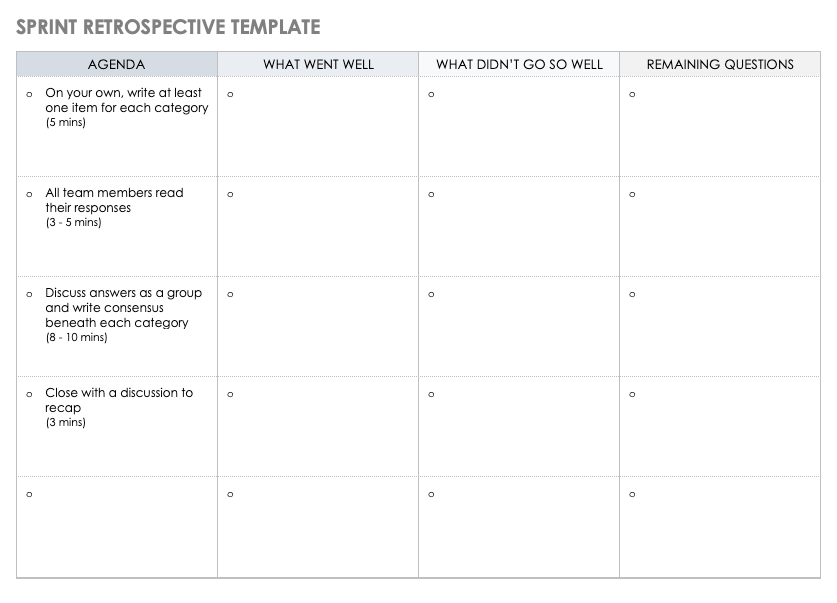

Then the team is asked how they feel about the results. The total scores are kept and the individual votes disposed of. Prisoners: feel like being forced to attend.Vacationers: not interested in retro but happy to be away from work.Shoppers: look for useful info and happy go home with 1 idea.Conversation vs Argument, Understanding vs DefendingĮSVP: The team anonymously identify their attitude towards retrospectives as one of the following:

Next, the Scrum Master/Team Leader sets an agenda and rules for the meeting. To increase comfort level of team members to participate in the meeting the team can play the following gamesĬheck In: Round robin where people give 2 sentences on what they want to get out of retroįocus On/Off: Get people give their opinion on each pair of words ie. It is recommended to get people talking early by introducing themselves and their role but if the team members don’t change very often this might be seen as overkill. Retrospectives work best when there is a lot of engagement and genuine feedback from the team. Setting the stage is all about setting the tone of the meeting and getting the team on board. If used correctly retrospectives can result in:Įsther Derby and Diana Larsen defined a 5 step process for holding retrospectives. Retrospectives can be highly effective as they happen during development process providing immediate feedback on how the process is performing. Generally, a retrospective is time-boxed to 2 hours and is based on brainstorming solutions and commit to a solution and discuss again, if success adds to the process. There are 3 core questions that should be answered in every retrospective: The aim of the retrospective is to improve methods and teamwork by reviewing the past iteration/release.

Setting the stage by introducing the retrospective topics and templates so that members can be ready with their feedback.
#Project retrospective free
Start with Icebreakers where they play simple games to bring members together and set the atmosphere for members to feel free to give honest feedback.

During the meeting, teams need to come together and share ideas. These meetings are ideal for team building and also finding loopholes in the development process. Retrospective technique are short meetings held at end of every team sprint.
#Project retrospective how to
Retrospectives bring a team together giving an opportunity to celebrate what went well but also to reflect on what could of went better and how to improve, RetroTool | Online, remote retrospectives made easy (Free and easy to use without login) Facilitating a Sprint Retrospective As an Agile coach it is your responsibility to put the team at ease. The team felt comfortable around each other and weren’t worried about what they say. The best retrospective I have attended were the less serious easy going meetings. However, this method gets boring and that is why agile retrospective templates come in. The easiest way is for every member of the team to enter their feedback on a spreadsheet and then action items are taken if the feedback requires it. There are several ways to hold a agile retrospective event. It should be an open discussion where everyone gives their honest feedback. The team will provide feedback on the progress of a project. The idea behind retrospection is to find out what went well, what could be improved, and what could have been done better to help facilitate continuous improvement. Regardless if its XP, Scrum, Kanban, retrospection is one of the most important events in bringing a team success. We spend enough time being serious at work. Keeping your agile team engaged is critical so trying a different using different end of sprint retrospective examples can spruce things up.


 0 kommentar(er)
0 kommentar(er)
